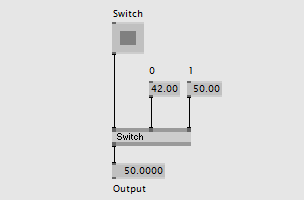Conditions
Patching pages
Switch
 |
Basic usageIn the most simplest scenario you want to switch between two inputs according to the result of some boolean operation (0 and 1). This is what the Switch (Value Input) is for. By default the Switch node has 2 inputs to switch between: in case of 0 Input 1 and in case of 1 Input 2. |
 |
More InputsThe Switch node can accept any number of inputs to switch between by setting the Input Count via the Inspektor. The Switch input then takes an integer value ranging from 0 to Count-1 to switch between the inputs. See also
|
 |
SpreadsAlternatively to switching between multiple individual values you can use the GetSlice (Spreads) as shown to switch between the slices of a spread. |
Boolean operations
 |
Boolean operationsThere is no special Boolean datatype in vvvv. Boolean values are simply represented by 0 (false, off) and 1 (true, on). Use the following nodes for basic boolean operations: Relational operators>, <, =,... return 0 or 1. State conditionsThere are some special nodes that return a Boolean according to a change in state. Examples:
See the helppatches of these nodes for details. |
State Automatas
 |
When patching anything that can be separated into a series of states and events that cause transition from one state to another you are likely looking for Automata (Animation). Also the Timerliner has an automata built in. See also: |
anonymous user login
Shoutbox
~4h ago
~7d ago
~7d ago
~7d ago
~21d ago
~1mth ago
~1mth ago
~1mth ago
~1mth ago
~1mth ago

